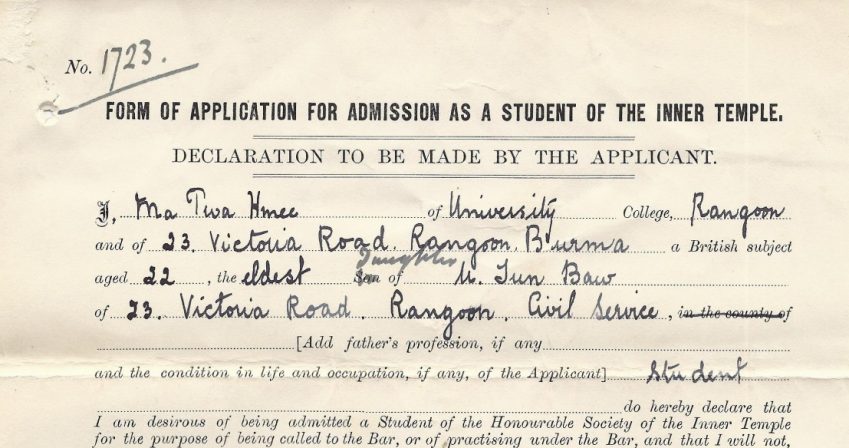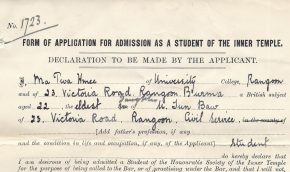First woman to practise as a barrister in Burma
Women in Law
- Introduction
- Timeline
- Joyce Bamford-Addo
- Marion Billson
- Jill Black
- Elizabeth Butler-Sloss
- Eugenia Charles
- Lynda Clark
- Freda Corbet
- Coomee Rustom Dantra
- Leeona Dorrian
- Heather Hallett
- Frene Ginwala
- Rosalyn Higgins
- Daw Phar Hmee
- Lim Beng Hong
- Dorothy Knight Dix
- Sara Lawson
- Elizabeth Lane
- Theodora Llewelyn Davies
- Gladys Ramsarran
- Lucy See
- Evelyn Sharp
- Victoria Sharp
- Ingrid Simler
- Teo Soon Kim
- Ivy Williams
- The Significance of the Sex Disqualification (Removal) Act 1919
- Podcasts
Home › Women in Law › Our Women › Daw Phar Hmee
Daw Phar Hmee
Admitted 1924, Called 1926
Was admitted to the Inn on 25 January 1924. As a strong supporter of women’s rights, she initially decided to become a lawyer in order to benefit the women of Burma, believing that:
One of her letters of testimonial for entry to this Inn was written by the former Lieutenant Governor of Burma Harvey Adamson, who stated that:
her family is well known and respected in Burma. Her father holds a position of trust in Rangoon Municipality. Ma Pwa Hmee has come to England to study for the Bar, an enterprise which I believe no other Burmese lady has hitherto undertaken. From what I see and hear I am confident she is worthy of encouragement.
She was called to the Bar on 17 November 1926. As only one of two women to be called to the Bar she attracted the attention of the press and was interviewed, providing us with a description on London and Londoners through the eyes of a Burmese student in London:
Never in my life had I seen people in such a hurry as those tearing down the streets of London. I thought that their haste must be due to some special attraction in the next street. In one of the busy streets of the West End I remember waiting five or ten minutes to cross the road, and expecting the traffic to wait for me. Another of my difficulties was in understanding the language of the bus conductor who several times told me to ‘Ole tight’. [1]
She also mentioned the dress of the British girl:
the bearing of the British people, their erect bodies and even strides which show they have loved for generations long walks in the open air. [2]
On December 10 she boarded the boat to Rangoon and in 1927 she became the first woman to be called to the Bar in Rangoon.
Eight years later in February 1935 she made history again when she was appointed one of the first Honorary Magistrates in Rangoon
She married U Myint Thein, also a barrister and called to the Bar at Lincoln’s Inn in 1925 and Chief Justice in Burma from 1957 to 1962.
[1] Woman Barrister form Burma, Dundee Courier, 10 December 1926
[2] The Daily Telegraph, 18 November 1926


Ma Pwa Hmee's Admission Form